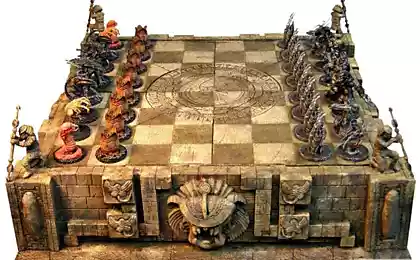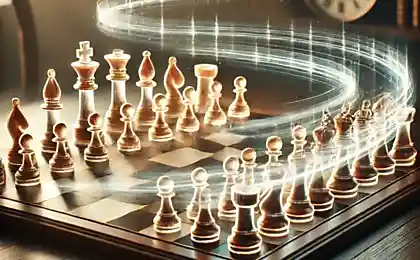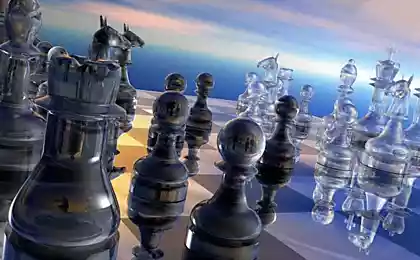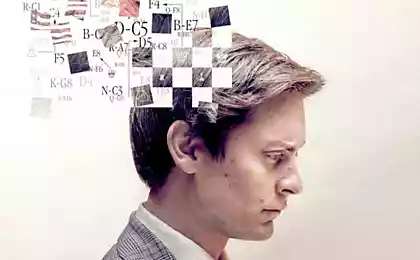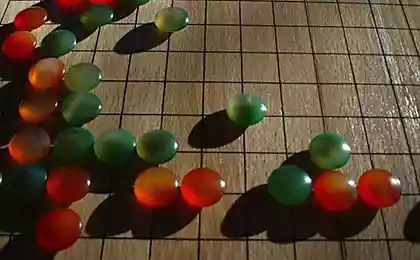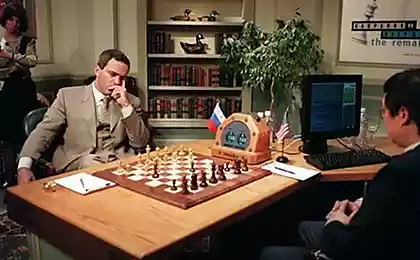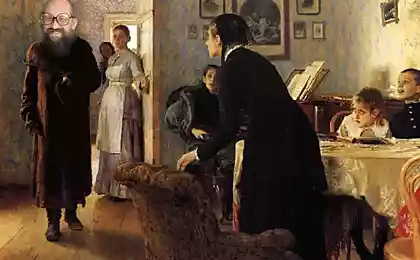928
What You did not know about chess
I propose to escape from direct contact with the world of it and pay attention to a variety of exercise equipment for the brain as game.
Now in many offices specially conduct the collective Board games that help distract from the routine (to increase productivity) and the positive effect of establishing good relations in the team. This article is a brief excursion into the history of one of the most important games of humanity — CHESS.
In the modern form of this famous and well-known Board game like chess did not appear immediately. To the familiar version of the Board game had to undergo a number of changes and shapes. Now "chess" is a class of games.
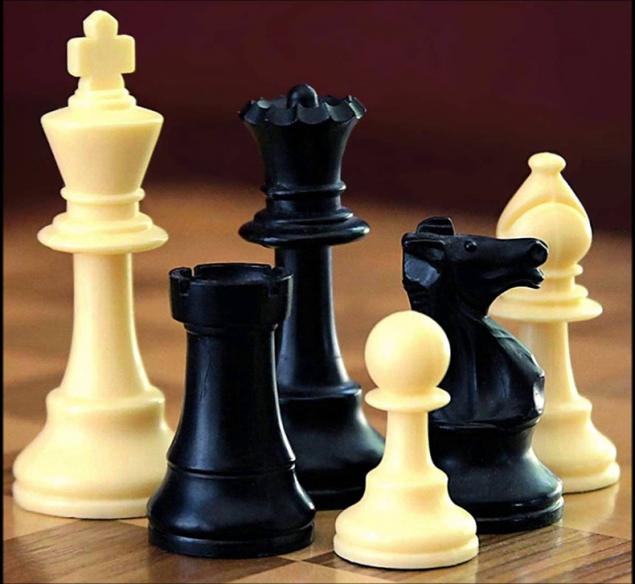
Some of the Board games in this class are independent, original and considerably different from the modern ideas of chess.
In addition to the well-known classical chess, there are many other variants of chess. There are national variants of chess, for example, common in South Asia, Xiangqi, Shogi, Chang, makruk. Some variants use additional shapes and/or unusual boards, known variants on larger boards, round boards, with figures, combining the moves of knight and rook and/or knight and Bishop, with the Maharajah (a figure that combines the moves of Queen and knight) instead of a Queen, hexagonal chess (played on a hexagonal Board consisting of a field of hexagons).
There are chess for more than two players: three - and four-sided chess, in which one Board is played by three or four players (two on two or every man for himself), managing each their set of figures and "team" versions of chess, where the game is played in a team on one or several boards, and in the course of the party for one Board affect more than one player from each team (for example, the Swedish chess).
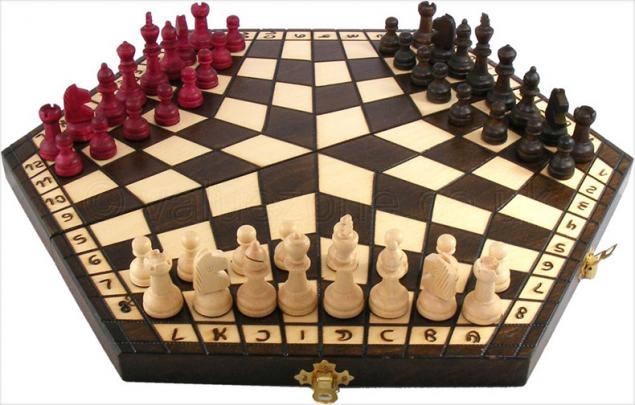
The invention of new variants of a chess addicted chess composers", as well as scientists, chess players-Amateurs and professionals. Known, for example, Capablanca chess — on a Board 10×8, with two new pieces.
Recently becoming increasingly popular Fischer chess, the game has classic rules, but with random initial placement of the pieces on the last rank. In terms of options, the rules have remained unchanged (or minimally changed), and changed only the initial arrangement of the figures. Besides the already mentioned chess and Fischer random chess and freestyle chess, these are kingchess and battle chess.
According to the classification of Robert bell chess belong to the same group of table games are "war games".
In the group of "Chess" are the following games:
So, let's proceed with the consideration of games of CHESS ancestors. Please refer to the history of the Ancient East.
CHATURANGA (CHATURANGA)
In agricultural areas of the Ancient India among the population in the ripening period was a popular game TEAM. It was played on a square field consisting of 64 squares that mark on the ground. The game itself is not classified chess games and was a game-pursuit, in which the figures were moving counterclockwise on the field with the objective of achieving the midfield. Of the players who first deduced their figure from the field, and won.
Approximately in the 5th century BC on the Board for the game TEAM began to play a new game, CHATURANGA, which in miniature is a battle of four armies, each controlled by its own commander (original Raj) and consists of four types of troops: infantry, cavalry, war elephants and battle boats (I think the name of this figure "rook" is associated with this).
CHATURANGA (in some sources — CHATURANGA) is an ancient Indian game that is considered the ancestor of chess, Shogi and many other games. Chaturanga — game, common in the East and later those in Europe, from which came the modern chess.
The name "Chaturanga" is translated as "four component" and presumably due to the fact that originally it was played as a four. Chaturanga in ancient India was called an army, consisting of chariots (Ratha) and elephants (hasti), the cavalry (ashwa) and foot soldiers (padati). The game symbolized the battle with four arms, which was led by leader (Raja).
The game involved four players, and "battle" on the playing field were organized by unions of players (play "two by two").
Description CHATURANGI is present in one of the early works in Sanskrit, "Bhavishya Purana.
In this work, is the story of what one of the rulers has lost all his possessions (including his own wife) in the bone. After that, he went to his old friend, to master the secrets of the game Chaturanga to win.
The rules of the game are unknown, the available information is incomplete and contradictory. The main source of information is the treatise of XI century, Khorezm scholar al-Biruni, which contains only a partial description of Chaturanga. In addition, the rules of Chaturanga certainly had local options, and definitely has changed over time.
Due to the low mobility figures in the party Chaturanga lasted very long — 100 — 200 moves.
In the game for four players used sets of figures in four colors: black, green, yellow and red. Played a couple for a couple. Each set contains eight figures: Raju (king), elephant, horse, chariot (similar to the rook and four pawns. The players took their places at the sides of the playing field. Figures lined up in the lower left corner of the Board (relative to player). On the first line (from the player): the elephant in the corner, followed by the horse, the chariot and Raja. On the second line — the number of pawns.
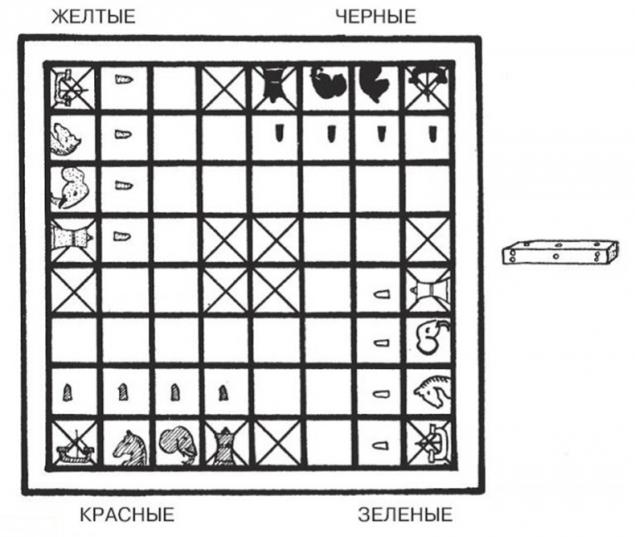
The purpose of the game is conditional destruction of the whole army of the enemy. The party lasted until the destruction of all the pieces of one of the parties. In the two-player game, the victory was also achieved by taking the enemy king. No such thing as Shah, Matt and Pat. Taking all the pieces except the king (Baring the king) was also a victory, unless the enemy could take your last piece on the next move. Then was declared a draw. In addition, CHATURANGI were a number of features.
For example, the right "first move" was defined by the numbers when throwing dice games (the progenitor of the modern game cubes with dots from 1 to 6). The player before the move threw the dice and dropped the value indicated on the figure, which he needs to make a move.
According to historical sources, Chaturanga was invented in India where it was a game, mainly intellectuals of the higher castes. No information about the realization of official competitions in those days were not preserved. Are records of games played. Chaturanga existed in India before the beginning of the XX century and, according to the testimony of Bengali author Raghunanda (XV-XVI centuries), was eventually to be called "Chaturanga" — "the four kings".
In the sixth or perhaps the seventh century Chaturanga was in China, and Persia (Iran). In China, the game variant for two players, was essentially transformed, becoming as a result, in the Chinese Xiangqi. In the countries of the Arab East Chaturanga for several centuries was modified, retaining, however, the main features. In the end, there was a game-descendant — shatranj, which later evolved into chess.
In addition, CHATURANGA was originally a gambling game. Before the game all players put a certain amount of money at stake. The prize was divided between the winners.
Gambling was banned in the early periods hinduisme culture. About it legends in the ninth book of the "law of Manu":
"May the Lord punish corporal its sole and absolute discretion of the player, and the owner playing facilities, even if they are dealing with inanimate objects, such as bones or Chaturanga, or living beings, for example, the cockfight to the blood and battle rams.
Players bypassed the requirements of the act by refusing Dyce. After that game there was a number of changes:
First, the game was the unification of the allied forces into a single army. The game transformed into a game for two. In the game for two players used two sets of figures. Each set contains eight pawns, two bishops, two knights, two chariots, the Raja, and Advisor (vizier) — an analogue of the Queen. The build order of the shapes before the party was the same as in modern chess.
Second, the figure of Raja allies after the reduction to the adviser (vizier) has lost some of its "impact" on the gameplay.
Third, change the way of movement on the playing field of the figures of the chariots (Ratha) and elephants (hasti).
After the introduction of these transformations is going to be called CHATURANGA and turned into the initial version of a medieval chess SHATRANJ.
SHATRANJ
Shatranj was formed in VII — VIII century in the Arab East, as a modified version of Chaturanga, who came from India.
The poet Ferdowsi in his poem "Shahnameh" has told about how chess came to Persia:
"To the court of Shah Chosroes I came to the Embassy from the ruler of hind. After an exchange of courtesies, the Ambassador of hind gave the Shah many gifts, among which was an amazing checkered Board, which was intricately carved figures. The Ambassador invited the Shah and his wise men to understand the rules of this game and then the Supreme ruler Hinda werheim recognize him as their ruler. The Board showed all the courtiers and the next day one of them (according to the poem — Buzurjmihr) has figured out the secret to this game. Rulers of Ancient India acknowledged his vassalage of Persia.".
Most likely day left to bribe the Ambassador, to find out the rules of the game.
In subsequent years, SHATRANJ penetrates across the Arab world and Byzantium.
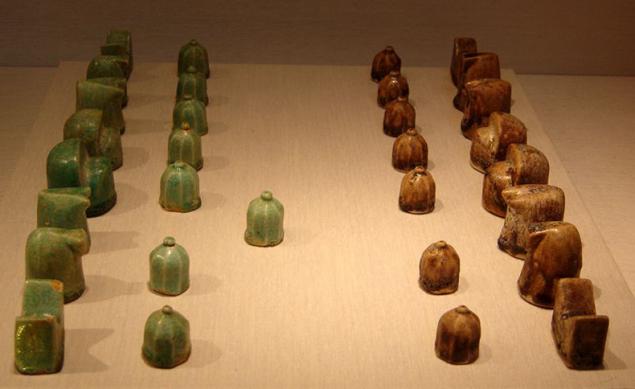
Already in the IX century the game was extremely popular in Central Asia. Shatranj is played by representatives of all social strata. There was a recognized master of the game had its own hierarchy of classes of players. Actively developed theory. Books out, teaching art satranga. Was popular mancubi (tasks, mainly for the quick win combination).
Preserved "chess legends", in which a dramatic story (for example, a player who risked something recent, especially expensive, and was the latest instalment in the situation that looks hopeless), connected to the task, which usually achieved an unexpected and beautiful combination.
Organic lack satrangi — lack of dynamism, especially in the opening, caused by weakness inherited from the Chaturanga pieces. In the beginning of the game players can for a long time to make moves without coming into contact with the enemy. To spice up the game, the Arab masters began to apply tabia — artificially generated conditional positions, usually more or less symmetrical, in which the chances of the players were, as in the initial position of the party, are approximately equal.
By agreement, players start the game from the original position, and one of tabi, so that you can immediately go into action. Tabia was ubiquitous, applied very widely, as evidenced by this fact: when in the books cited fragments of parties, played from the start position, without tabi, it has always been particularly.
There was a quite interesting form of the game shatranj: the wizard developed a position and invited anyone who wanted to play him from this position on the bet, and the enemy were offered to choose what color to play. For such games were developed positions in which, at first glance, one of the sides had a serious advantage, however, this advantage could be reduced in any unexpected way.
In the IX century, in the period of the Arab conquest of Spain, shatranj came to Western Europe, where they evolved into modern chess. At the same time or somewhat earlier, through Central Asia, the game fell to Russia, under the modern name of "chess", which was adopted from the Persians and Tajiks.
Shatranj is played on a square Board of size 8x8 fields, similar to chess. The game involved two players, each of them had one set of pieces of his color (black and white). The set includes: king, Queen, two bishops, two knights, two rooks, and eight pawns. In the beginning of the game pieces are located on opposite sides of the Board, entirely analogous to classical chess except that the kings and the Queens can be swapped (but kings in any case, had to stand opposite each other).
The order of moves in SHATRANJ similar to modern chess.
The first move made by the player playing the white pieces. Then moves are made in turn. To pass the course impossible. Each move consists of movement in accordance with the rules of one of his pieces. The figure can be put on a blank Board or on a square occupied by enemy piece. In the second case, the opponent's piece is captured, removed from the Board and more not involved in the game.
The winner is the player who declared checkmate the opponent's king or put him in a position of stalemate. In addition, the player is declared the winner in the case of taking the last figure of the enemy (leaving him with a naked king, in some embodiments, satranga could be declared a draw if the opponent is in response also took the last figure).
Figure SATRANGA almost identical figures of modern chess, but the movement rules are slightly different:
The king (Shah) move one step in any direction. The situation when the king is under attack (can be taken by the enemy next turn), is called "Shah". The player whose king was under the Shah, the next move should take him out of check, to make other moves, leaving the king in check impossible.
The rook (Rukh) goes vertically or horizontally on any number of fields.
The horse (Faras) — similar to the chess knight-it's the only figure movement rules which has not changed for the entire period from Chaturanga to modern chess).
The elephant (alfil) goes diagonally across one field, and a field through which a move can be occupied (in modern chess, the Bishop can move only along the free diagonal on any number of fields). A very weak figure could only walk in eight fields of the Board (a modern elephant could walk on half of the fields).
The Queen (fers) can move one square diagonally (in modern chess the Queen can move any number of fields in any direction except the way the Queen blocks another figure).
Pawn (baydak) moves only forward one square, or hits it diagonally one space forward. A pawn that has reached the end of the Board, becomes a Queen. The first course of the new Queen had a right to go to the second field vertically or diagonally, regardless of whether this field is occupied.
Satranga according to the rules of the castling king and rook were not enabled (appeared in a much later rules of chess).
Today we know the following options satranga:
Shatranj Kamil I — version of the game on a 10x10 Board with two camels, additional shapes, which are orthogonal analogue of elephants. Perhaps this is the first variant of chess on an enlarged Board with unconventional shapes.
Shatranj Kamil II — version of the game on a 10x10 Board with two war machines (siege engines) are having the same moves as the king.
The citadel is also played on a 10x10 Board, but there were additional fields ("citadel") in the corners. The game was attended by additional figures combat vehicle that has the same moves as the modern elephant.
Long chess has the same pieces as regular shatranj, but is played on a Board 4x16. Often played with hex the bones, limiting the moves of the pieces.
Byzantine chess — game is conducted in the usual shapes, but on a round Board.
There is also a modern version with the same Board, but with modern figures and rules (circular chess).
The four seasons is shatranj for four players on an ordinary Board.
Tamerlane chess — variant Board games 11x10 fields-the citadels, several types of additional shapes and different pawns (probably introduced different kinds of troops for the infantry). The invention of the game is attributed directly to Tamerlane.
Chess courier (Courier chess) — the European version of the game on a 12x8 Board with several additional pieces, including the courier with the progress of modern elephant.
Many researchers believe that the classical chess appeared chess by courier.
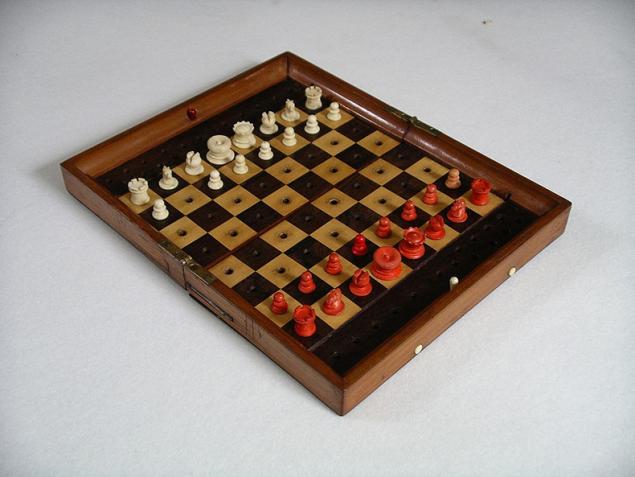
Thus, after a series of modifications, the game of CHESS appeared in Europe and the middle East. But chess moves was not only on the West. With merchants, travelers, and conquerors of the ancient game of chess has penetrated to Asia. Here are the rules of this game mixed with the local rules of national games, like the gaze of the inhabitants of the region and representation of strategic games.
In South East Asia an exciting and original game Xiangqi (China), makruk (Thailand) and Shogi (Japan). In Asia, these games even more popular than classical chess. But this is the next story. published
P. S. And remember, only by changing their consumption — together we change the world! ©
Join us in Facebook , Vkontakte, Odnoklassniki
Source: geektimes.ru/post/270554/
Now in many offices specially conduct the collective Board games that help distract from the routine (to increase productivity) and the positive effect of establishing good relations in the team. This article is a brief excursion into the history of one of the most important games of humanity — CHESS.
In the modern form of this famous and well-known Board game like chess did not appear immediately. To the familiar version of the Board game had to undergo a number of changes and shapes. Now "chess" is a class of games.

Some of the Board games in this class are independent, original and considerably different from the modern ideas of chess.
In addition to the well-known classical chess, there are many other variants of chess. There are national variants of chess, for example, common in South Asia, Xiangqi, Shogi, Chang, makruk. Some variants use additional shapes and/or unusual boards, known variants on larger boards, round boards, with figures, combining the moves of knight and rook and/or knight and Bishop, with the Maharajah (a figure that combines the moves of Queen and knight) instead of a Queen, hexagonal chess (played on a hexagonal Board consisting of a field of hexagons).
There are chess for more than two players: three - and four-sided chess, in which one Board is played by three or four players (two on two or every man for himself), managing each their set of figures and "team" versions of chess, where the game is played in a team on one or several boards, and in the course of the party for one Board affect more than one player from each team (for example, the Swedish chess).

The invention of new variants of a chess addicted chess composers", as well as scientists, chess players-Amateurs and professionals. Known, for example, Capablanca chess — on a Board 10×8, with two new pieces.
Recently becoming increasingly popular Fischer chess, the game has classic rules, but with random initial placement of the pieces on the last rank. In terms of options, the rules have remained unchanged (or minimally changed), and changed only the initial arrangement of the figures. Besides the already mentioned chess and Fischer random chess and freestyle chess, these are kingchess and battle chess.
According to the classification of Robert bell chess belong to the same group of table games are "war games".
In the group of "Chess" are the following games:
- Chaturanga (Chaturanga);
- shatranj;
- circular chess (a kind of satrangi);
- courier chess (another variant of satrangi);
- Maharajah and the sepoys;
- Eastern chess;
- Chinese chess (Xiangqi);
- Japanese chess (Shogi);
- game jungle;
- Tibetan chess.
So, let's proceed with the consideration of games of CHESS ancestors. Please refer to the history of the Ancient East.
CHATURANGA (CHATURANGA)
In agricultural areas of the Ancient India among the population in the ripening period was a popular game TEAM. It was played on a square field consisting of 64 squares that mark on the ground. The game itself is not classified chess games and was a game-pursuit, in which the figures were moving counterclockwise on the field with the objective of achieving the midfield. Of the players who first deduced their figure from the field, and won.
Approximately in the 5th century BC on the Board for the game TEAM began to play a new game, CHATURANGA, which in miniature is a battle of four armies, each controlled by its own commander (original Raj) and consists of four types of troops: infantry, cavalry, war elephants and battle boats (I think the name of this figure "rook" is associated with this).
CHATURANGA (in some sources — CHATURANGA) is an ancient Indian game that is considered the ancestor of chess, Shogi and many other games. Chaturanga — game, common in the East and later those in Europe, from which came the modern chess.
The name "Chaturanga" is translated as "four component" and presumably due to the fact that originally it was played as a four. Chaturanga in ancient India was called an army, consisting of chariots (Ratha) and elephants (hasti), the cavalry (ashwa) and foot soldiers (padati). The game symbolized the battle with four arms, which was led by leader (Raja).
The game involved four players, and "battle" on the playing field were organized by unions of players (play "two by two").
Description CHATURANGI is present in one of the early works in Sanskrit, "Bhavishya Purana.
In this work, is the story of what one of the rulers has lost all his possessions (including his own wife) in the bone. After that, he went to his old friend, to master the secrets of the game Chaturanga to win.
The rules of the game are unknown, the available information is incomplete and contradictory. The main source of information is the treatise of XI century, Khorezm scholar al-Biruni, which contains only a partial description of Chaturanga. In addition, the rules of Chaturanga certainly had local options, and definitely has changed over time.
Due to the low mobility figures in the party Chaturanga lasted very long — 100 — 200 moves.
In the game for four players used sets of figures in four colors: black, green, yellow and red. Played a couple for a couple. Each set contains eight figures: Raju (king), elephant, horse, chariot (similar to the rook and four pawns. The players took their places at the sides of the playing field. Figures lined up in the lower left corner of the Board (relative to player). On the first line (from the player): the elephant in the corner, followed by the horse, the chariot and Raja. On the second line — the number of pawns.

The purpose of the game is conditional destruction of the whole army of the enemy. The party lasted until the destruction of all the pieces of one of the parties. In the two-player game, the victory was also achieved by taking the enemy king. No such thing as Shah, Matt and Pat. Taking all the pieces except the king (Baring the king) was also a victory, unless the enemy could take your last piece on the next move. Then was declared a draw. In addition, CHATURANGI were a number of features.
For example, the right "first move" was defined by the numbers when throwing dice games (the progenitor of the modern game cubes with dots from 1 to 6). The player before the move threw the dice and dropped the value indicated on the figure, which he needs to make a move.
According to historical sources, Chaturanga was invented in India where it was a game, mainly intellectuals of the higher castes. No information about the realization of official competitions in those days were not preserved. Are records of games played. Chaturanga existed in India before the beginning of the XX century and, according to the testimony of Bengali author Raghunanda (XV-XVI centuries), was eventually to be called "Chaturanga" — "the four kings".
In the sixth or perhaps the seventh century Chaturanga was in China, and Persia (Iran). In China, the game variant for two players, was essentially transformed, becoming as a result, in the Chinese Xiangqi. In the countries of the Arab East Chaturanga for several centuries was modified, retaining, however, the main features. In the end, there was a game-descendant — shatranj, which later evolved into chess.
In addition, CHATURANGA was originally a gambling game. Before the game all players put a certain amount of money at stake. The prize was divided between the winners.
Gambling was banned in the early periods hinduisme culture. About it legends in the ninth book of the "law of Manu":
"May the Lord punish corporal its sole and absolute discretion of the player, and the owner playing facilities, even if they are dealing with inanimate objects, such as bones or Chaturanga, or living beings, for example, the cockfight to the blood and battle rams.
Players bypassed the requirements of the act by refusing Dyce. After that game there was a number of changes:
First, the game was the unification of the allied forces into a single army. The game transformed into a game for two. In the game for two players used two sets of figures. Each set contains eight pawns, two bishops, two knights, two chariots, the Raja, and Advisor (vizier) — an analogue of the Queen. The build order of the shapes before the party was the same as in modern chess.
Second, the figure of Raja allies after the reduction to the adviser (vizier) has lost some of its "impact" on the gameplay.
Third, change the way of movement on the playing field of the figures of the chariots (Ratha) and elephants (hasti).
After the introduction of these transformations is going to be called CHATURANGA and turned into the initial version of a medieval chess SHATRANJ.
SHATRANJ
Shatranj was formed in VII — VIII century in the Arab East, as a modified version of Chaturanga, who came from India.
The poet Ferdowsi in his poem "Shahnameh" has told about how chess came to Persia:
"To the court of Shah Chosroes I came to the Embassy from the ruler of hind. After an exchange of courtesies, the Ambassador of hind gave the Shah many gifts, among which was an amazing checkered Board, which was intricately carved figures. The Ambassador invited the Shah and his wise men to understand the rules of this game and then the Supreme ruler Hinda werheim recognize him as their ruler. The Board showed all the courtiers and the next day one of them (according to the poem — Buzurjmihr) has figured out the secret to this game. Rulers of Ancient India acknowledged his vassalage of Persia.".
Most likely day left to bribe the Ambassador, to find out the rules of the game.
In subsequent years, SHATRANJ penetrates across the Arab world and Byzantium.

Already in the IX century the game was extremely popular in Central Asia. Shatranj is played by representatives of all social strata. There was a recognized master of the game had its own hierarchy of classes of players. Actively developed theory. Books out, teaching art satranga. Was popular mancubi (tasks, mainly for the quick win combination).
Preserved "chess legends", in which a dramatic story (for example, a player who risked something recent, especially expensive, and was the latest instalment in the situation that looks hopeless), connected to the task, which usually achieved an unexpected and beautiful combination.
Organic lack satrangi — lack of dynamism, especially in the opening, caused by weakness inherited from the Chaturanga pieces. In the beginning of the game players can for a long time to make moves without coming into contact with the enemy. To spice up the game, the Arab masters began to apply tabia — artificially generated conditional positions, usually more or less symmetrical, in which the chances of the players were, as in the initial position of the party, are approximately equal.
By agreement, players start the game from the original position, and one of tabi, so that you can immediately go into action. Tabia was ubiquitous, applied very widely, as evidenced by this fact: when in the books cited fragments of parties, played from the start position, without tabi, it has always been particularly.
There was a quite interesting form of the game shatranj: the wizard developed a position and invited anyone who wanted to play him from this position on the bet, and the enemy were offered to choose what color to play. For such games were developed positions in which, at first glance, one of the sides had a serious advantage, however, this advantage could be reduced in any unexpected way.
In the IX century, in the period of the Arab conquest of Spain, shatranj came to Western Europe, where they evolved into modern chess. At the same time or somewhat earlier, through Central Asia, the game fell to Russia, under the modern name of "chess", which was adopted from the Persians and Tajiks.
Shatranj is played on a square Board of size 8x8 fields, similar to chess. The game involved two players, each of them had one set of pieces of his color (black and white). The set includes: king, Queen, two bishops, two knights, two rooks, and eight pawns. In the beginning of the game pieces are located on opposite sides of the Board, entirely analogous to classical chess except that the kings and the Queens can be swapped (but kings in any case, had to stand opposite each other).
The order of moves in SHATRANJ similar to modern chess.
The first move made by the player playing the white pieces. Then moves are made in turn. To pass the course impossible. Each move consists of movement in accordance with the rules of one of his pieces. The figure can be put on a blank Board or on a square occupied by enemy piece. In the second case, the opponent's piece is captured, removed from the Board and more not involved in the game.
The winner is the player who declared checkmate the opponent's king or put him in a position of stalemate. In addition, the player is declared the winner in the case of taking the last figure of the enemy (leaving him with a naked king, in some embodiments, satranga could be declared a draw if the opponent is in response also took the last figure).
Figure SATRANGA almost identical figures of modern chess, but the movement rules are slightly different:
The king (Shah) move one step in any direction. The situation when the king is under attack (can be taken by the enemy next turn), is called "Shah". The player whose king was under the Shah, the next move should take him out of check, to make other moves, leaving the king in check impossible.
The rook (Rukh) goes vertically or horizontally on any number of fields.
The horse (Faras) — similar to the chess knight-it's the only figure movement rules which has not changed for the entire period from Chaturanga to modern chess).
The elephant (alfil) goes diagonally across one field, and a field through which a move can be occupied (in modern chess, the Bishop can move only along the free diagonal on any number of fields). A very weak figure could only walk in eight fields of the Board (a modern elephant could walk on half of the fields).
The Queen (fers) can move one square diagonally (in modern chess the Queen can move any number of fields in any direction except the way the Queen blocks another figure).
Pawn (baydak) moves only forward one square, or hits it diagonally one space forward. A pawn that has reached the end of the Board, becomes a Queen. The first course of the new Queen had a right to go to the second field vertically or diagonally, regardless of whether this field is occupied.
Satranga according to the rules of the castling king and rook were not enabled (appeared in a much later rules of chess).
Today we know the following options satranga:
Shatranj Kamil I — version of the game on a 10x10 Board with two camels, additional shapes, which are orthogonal analogue of elephants. Perhaps this is the first variant of chess on an enlarged Board with unconventional shapes.
Shatranj Kamil II — version of the game on a 10x10 Board with two war machines (siege engines) are having the same moves as the king.
The citadel is also played on a 10x10 Board, but there were additional fields ("citadel") in the corners. The game was attended by additional figures combat vehicle that has the same moves as the modern elephant.
Long chess has the same pieces as regular shatranj, but is played on a Board 4x16. Often played with hex the bones, limiting the moves of the pieces.
Byzantine chess — game is conducted in the usual shapes, but on a round Board.
There is also a modern version with the same Board, but with modern figures and rules (circular chess).
The four seasons is shatranj for four players on an ordinary Board.
Tamerlane chess — variant Board games 11x10 fields-the citadels, several types of additional shapes and different pawns (probably introduced different kinds of troops for the infantry). The invention of the game is attributed directly to Tamerlane.
Chess courier (Courier chess) — the European version of the game on a 12x8 Board with several additional pieces, including the courier with the progress of modern elephant.
Many researchers believe that the classical chess appeared chess by courier.

Thus, after a series of modifications, the game of CHESS appeared in Europe and the middle East. But chess moves was not only on the West. With merchants, travelers, and conquerors of the ancient game of chess has penetrated to Asia. Here are the rules of this game mixed with the local rules of national games, like the gaze of the inhabitants of the region and representation of strategic games.
In South East Asia an exciting and original game Xiangqi (China), makruk (Thailand) and Shogi (Japan). In Asia, these games even more popular than classical chess. But this is the next story. published
P. S. And remember, only by changing their consumption — together we change the world! ©
Join us in Facebook , Vkontakte, Odnoklassniki
Source: geektimes.ru/post/270554/
How to clean the toilet with only 2 NATURAL ingredients
How Richard Branson and Other Leaders Spend Their Free Time


